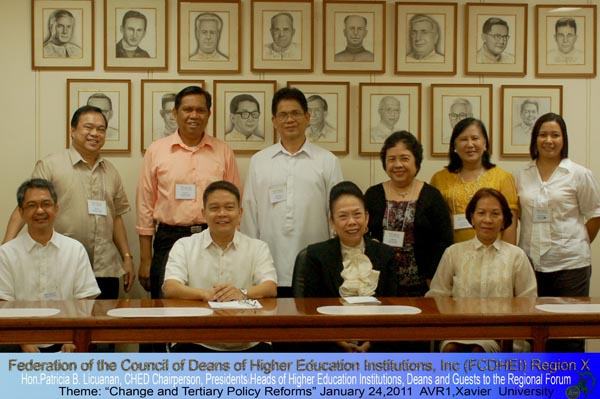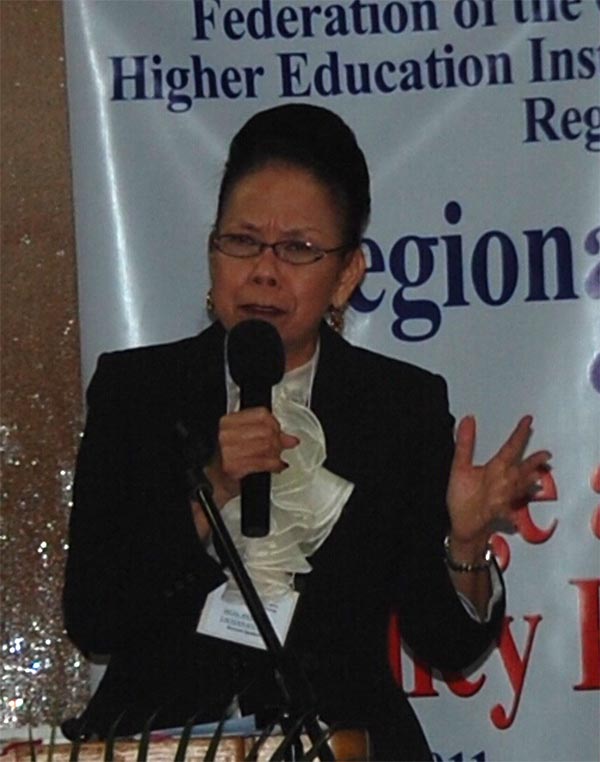
The revitalization of the country’s higher education institutions (HEI) is a front-burner issue and a top priority for CHED, according to Commission on Higher Education (CHED) Chairperson Dr Patricia Licuanan. She was recently in Cagayan de Oro upon the invitation of the Federation of the Council of Deans of Higher Education Institutions (FCDHEI) in Region 10.
FCDHEI-10, in trying to promote the exchange of ideas and concerns to develop better policies for better education, held a forum, drawing about 250 people composed of school presidents, deans and administrators across the region.  Licuanan bemoaned the poor academic achievement our schools suffer from, which she said indicates the lack of overall vision, framework and plan for education.
Licuanan bemoaned the poor academic achievement our schools suffer from, which she said indicates the lack of overall vision, framework and plan for education.
The latest national data peg the number of HEIs at 1,791, with 81 of them operating in Region 10.
“There are too many HEIs,” said Licuanan comparing the Philippines with bigger countries that have bigger populations but fewer HEIs. “It’s something I’m concerned about.”
Of the total number of HEIs in the country, CHED estimates that only about 5.6% can be assumed to have adequate facilities. This problem is compounded by inadequate faculty credentials and the lack of accreditation of several HEIs and programs.
These challenges are manifesting in the quality of students our schools produce.
Performance of graduates in licensure exams has sloped down across all disciplines. Between 2001 and 2008, the number of examinees who failed in licensure exams administered by the Philippine Regulation Commission surpassed the number of those who passed the test by about 64%.
“[The drop] is not as steep in Region 10, but it is still the same pattern of decline in licensure exams,” Licuanan said.
Furthermore, the country remains to have large underemployment and unemployment rates partially because of a mismatch of skills and jobs available. There are hard-to-fill jobs in science and technology as it is an undersubscribed program along with agriculture and fisheries, said Licuanan. Industries also want human resource with strong communication, numerical and technical skills.
But CHED is serious about addressing the basic flaws in Philippine education that in their recent strategic planning, three concrete measures were identified: rationalization of HEIs, improving quality of standards, and increasing access to quality education.
CHED is working on aligning HEIs with the national development goals to build the human capital needed for the country’s growth. In fact, CHED is involved in the discussions on K+12, a program of the Department of Education that will add two more years to high school, stretching basic education to 12 years.
“We expect that with the K+12, HEI programs can be shortened if some of the courses can already be incorporated into basic education,” Licuanan said.
She bared plans of developing a realistic set of typology suited to the Philippine education setting, and the amalgamation of HEIs to avoid duplication of programs within the same region, which Licuanan hopes will facilitate the establishment of regional university systems and specialized university systems.
CHED also intends to issue a moratorium on new HEIs offering oversubscribed programs such as business administration, nursing, hotel and restaurant management, information technology, teacher education and maritime. Applications for permits in oversubscribed programs that are already in the pipeline may still be approved depending on how far along in the process they are.
Correspondingly, Licuanan said that CHED will be aggressively closing down and phasing out substandard HEIs and programs. She emphasized compliance to standards and admonished against creative arrangements like one-year PhD programs and distance learning courses.
However, Licuanan expressed that CHED will assist schools get started on quality assurance and help them get accreditation. She also pointed out that CHED Policies, Standards and Guidelines will be kept to the minimum to allow HEIs more academic freedom.
The goal is for HEIs around the nation to prosper or perish based on the strength of their programs.
Since private schools are finding it hard to compete against brick-and-mortar state universities and colleges, CHED is looking to level the playing field and harmonize public and private HEIs. Discussions to standardize instruments of various accrediting agencies are ongoing although that needs to be looked into more deeply. Efforts to improve and expand programs on government assistance to students and teachers in private education (GATSPE) and student financial assistance are afoot.
Licuanan also assured that education programs such as the Alternative Learning System (ALS), Expanded Tertiary Education Equivalency and Accreditation Program (ETEEAP), and ladderized education programs will get renewed interest from CHED to increase the public’s access to quality higher education.
CHED’s other plans include the country’s membership in the Washington Accord which will enable our engineering program to acquire international recognition and accreditation, making our engineers qualified to work abroad. A parallel initiative is the massive Brain-Gain program in partnership with the Philippine Development Foundation.
“We are re-evaluating our efforts to see what better way to keep our brains at home,” Licuanan said.
Although it will take time, Licaunan assured that CHED will not slough off the responsibility of fixing our education system’s problems.
“We have to develop stomach, political will and technical ammunition to accomplish that,” said Licuanan urging the cooperation of HEIs in the region.
She imparted that this time CHED will be less regulatory, less prescriptive and more developmental.
“CHED will be more supportive, consultative and collegial, but also very firm, very just and very decisive,” Licuanan remarked, underscoring that she “believe[s] in dialogue and win-win solutions.”
It was the Chairperson’s first time to address the FCDHEI-10 that not even a sudden power interruption toward the end of the forum kept the participants from engaging in the discussion.
